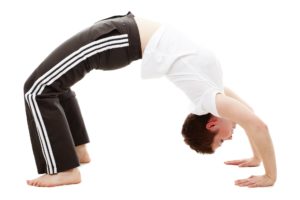 This cue may sound familiar in a Pilates class: “Don’t let the ribs pop! Knit them together, pull them in! Suck it in!”
This cue may sound familiar in a Pilates class: “Don’t let the ribs pop! Knit them together, pull them in! Suck it in!”
You definitely don’t hear this cue in Yoga…
This is one of the most dysfunctional Pilates cues I have ever heard –something I questioned in teacher training — and I was pleased to know after studying Osteopathic Sciences why it’s actually functional and good, to let those ribs “pop.”
A. Let’s do a little experiment, shall we?
1. Sit, stand, whatever feels most comfortable for you.
2. Reach an arm up overhead. Forward. From the side. Notice how much range there was.
3. Now suck in the belly and knit those ribs tightly. Pull them down. Don’t let them go. And while you’re doing that, try the same arm reach.
Point made?
4. Let’s try that experiment again. Take a breath in. Allow the ribs to pop open, let the belly pooch out. Notice how much air you take in.
5. Now try knitting those ribs together, don’t let go. And while you’re doing that, take a breath.
What did that feel like? Not very satisfying, right?
6. Try this again with a back-bend if you care to do so. You’ll again find that range of motion is affected by rib popping and rib knitting.
B. I want to direct you to a very cool old video of Joseph Pilates doing his exercises that he called Contrology, which we call Pilates today. Notice the rib popping. So if anyone claims to be teaching “authentic” Pilates, surely should not be cue-ing people to knit in the ribs?
Where did this cue originate? I suspect that it came from ballet aesthetics — lots of ballerinas went into teaching Pilates. Now it might be that this sort of cue might possibly maybe be helpful for a naturally hyper-mobile 16 year old dancer. But it surely is not helpful for your typical human being. People of all sorts go into Pilates, and over the past dozen years or so, Pilates has been marketed for rehabilitation of injuries, for people seeking greater flexibility and mobility. And as a result there are so many non-dancers in Pilates today, particularly a very solid group of desk-working professionals, retirees, non-dancing athletes, and more.
C. Anatomy-wise, these are inescapable facts, based in Osteopathic Sciences:
1. The ribs open when we breathe. Preventing this movement restricts the amount of breath we can take in.
2. The ribs attach to the spine and affect spine movement. Preventing rib movement restricts spine movement.
a. If you want to be more exact: Ribs push up on the transverse processes of the spine and compel the spine into extension. So when we breathe in, lungs expand — ribs open up, ribs move the spine into extension.
b. This also happens in arm-reaching because of how the arms attach to the shoulder blades, which attach to the collar bone, which attaches to the breast bone, which attaches to the ribs, which attach to the spine. It’s all connected, you see… so by the time you’re reaching the arm overhread, the spine is slightly extended. So the ribs will pop out.
c. When we deeply exhale, the abdominal muscles assist in pulling the ribs downward, and thus the ribs compel the spine into forward bending.
3. Therefore, if you’re constantly knitting in the ribs, basically by gripping abdominal muscles, you’re keeping the spine in a forward-bent position. How exactly does a normal person do a back bend if they’re forcing the body into a forward bend?
Again, if you’re a naturally hyper-mobile ballerina or contortionist, you can still do your backbends and arm reaching with these knitted in ribs. Because your ligaments are hyper-mobile. It’s still not necessarily functional cue-ing, however. If you’re the vast majority of the population with normal mobility or maybe not very flexible at all, this cue is going to keep you inflexible.
D. With one simple cue, I’ve convinced people that they didn’t actually have a self-diagnosed “frozen shoulder”, and I’ve helped older people with mobility issues reach higher without pain.
I have taken people who looked straight as a board, with very strained looking faces while trying to do a spine extension (like a Swan or Cobra), into easy spine extension in just a few group classes which only spent part of the time on spine extension exercises. They experience substantial improvement just in relaxation of neck muscles with just a few minutes on one exercise.
Take another look at the video of Joseph Pilates! If anyone was “authentic Pilates,” it would be him, right?
If you’re curious to know more, feel free to contact me through my website: www.lahelafit.com
Malama Pono,
Lahela
Pilates Method Alliance Certified Pilates Teacher
STOTT PILATES ® fully-certified Pilates Instructor
Franklin Method ® Level 3 Certified Movement Educator
LMT (Mat#6286) and Board-Certified (NCBTMB 307766-00)



… [Trackback]
[…] Informations on that Topic: lahelafit.com/time-to-rethink-some-common-pilates-cues-part-1-rib-popping/ […]